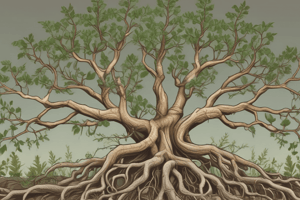Podcast
Questions and Answers
What are the three main functions of roots?
What are the three main functions of roots?
- Anchoring the plant, absorbing water and minerals, producing hormones (correct)
- Photosynthesis, respiration, reproduction
- Storing food, absorbing light, providing shade
- None of the above
Specialization in one area of roots can improve efficiency in all areas.
Specialization in one area of roots can improve efficiency in all areas.
False (B)
What do fleshy taproots primarily store?
What do fleshy taproots primarily store?
Carbohydrates
What type of root system do most monocots possess?
What type of root system do most monocots possess?
Most eudicots can undergo secondary growth.
Most eudicots can undergo secondary growth.
Roots grow from an ______ at the tip.
Roots grow from an ______ at the tip.
What is secreted by the dictyosomes in the root cap?
What is secreted by the dictyosomes in the root cap?
What can replace the apical meristem if it becomes damaged?
What can replace the apical meristem if it becomes damaged?
Match the following root meristems with their functions:
Match the following root meristems with their functions:
Flashcards are hidden until you start studying
Study Notes
Root Functions
- Roots have three main functions: anchoring the plant, absorbing water and minerals, and producing hormones.
- Specialization in one area of root function can negatively impact efficiency in other areas.
- Several types of roots may occur on one plant to minimize these problems.
- Some roots have additional functions, such as carbohydrate storage, producing new plants, hardening into spines, acting as holdfasts, and parasitizing other plants for nutrients and water.
External Root Structure
- Most seed plants have a single large taproot that develops from the radicle.
- The radicle may develop into a thick taproot with thinner branch roots.
- Most monocots and some eudicots have a fibrous root system with many similarly sized roots.
- Adventitious roots do not arise from pre-existing roots or the radicle.
- Many eudicots undergo secondary growth, increasing the amount of wood (xylem) in the trunk and roots, which allows for an increase in the number of leaves and absorptive roots.
- Most monocots cannot undergo secondary growth.
- The formation of adventitious roots can overcome the limitation of monocots lacking secondary growth.
Root Structure and Growth
- Roots grow from an apical meristem at the tip.
- The root apical meristem is protected by the root cap.
- There is a zone of elongation just behind the root cap and root apical meristem.
- Cells in the zone of elongation undergo cell division and expansion.
- The root hair zone is a region where epidermal cells extend out as narrow trichomes, increasing the root's surface area.
- New lateral roots emerge behind the root hair zone, increasing the absorption and transport capacities.
Internal Root Structure
- The root cap layer closest to the root meristem is meristematic.
- Cells on the edge of the root cap grow toward the side and proliferate.
- The middle lamella breaks down and releases cells, which are usually crushed by expansion of the root.
- Root cap cells protect tissues from damage as the root grows.
- The root apical meristem is the source of regular files of cells.
- There is a mitotically inactive central region known as the quiescent center, which can replace the apical meristem if it is damaged.
Root Tip
- The region of cell division is composed of the apical meristem, which is subdivided into three meristematic areas: protoderm, ground meristem, and procambium.
- Protoderm gives rise to the epidermis.
- Ground meristem gives rise to the cortex and pith.
- Procambium gives rise to the primary xylem and primary phloem.
Zone of Elongation
- The zone of elongation is the region beyond the meristematic region where cells are enlarging.
- Nuclei become less distinct.
- Protoderm, provascular tissue, and cortex cells are in the zone of elongation.
Studying That Suits You
Use AI to generate personalized quizzes and flashcards to suit your learning preferences.




